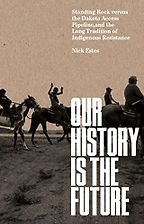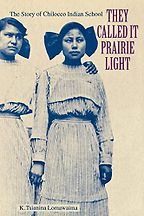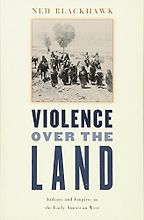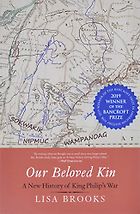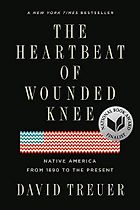Before we start on the books, a question about what’s driven your choices: were you trying to give a comprehensive overview of Native American history? Or have you tried to bring out certain specific themes?
One of the challenges I gave myself was to ask what my list would look like if I focused on work by Native scholars or Native writers. I wanted to prioritize the work being done by Native writers, both very recently and over the past 25 or 30 years as well, to get a sense of how Native scholars have been talking about historical issues and doing Native history over time. There’s a flowering of Native scholarship right now that is really exciting.
Let’s start with Our History is the Future by Nick Estes. What’s this one about and why have you chosen it?
I think this is one of the most exciting books to come out about Native American history in the past several years. That’s because it connects historical scholarship with a present-day issue. In this case, the protests against the Dakota Access Pipeline and the work done at Standing Rock by a variety of indigenous peoples and their allies. Even though the book is about a very recent event, the protests against the pipeline, Nick Estes explains that you can’t understand this protest without learning centuries of Lakota history, the ways that people have been protecting territory, sovereignty, land and water, for many centuries against invasion and other kinds of threats.
Estes also highlights Native women who have done protective work over time. Sometimes that has meant ecological activism, at others it has meant simply carrying children and caring for children in the most treacherous of circumstances, the work of survival. Overall, I like the way that he highlights the work of Native women within that centuries-long story of activism.
Let’s move on to the next one, which is Our Beloved Kin by Lisa Brooks.
This book won the Bancroft Prize so, clearly, I’m not the only person who recognizes how amazing it is. It looks at an event that you might know well if you’ve taken an American history class, King Philip’s War. And you will probably have heard about some of the Native actors associated with that conflict, namely, the person denoted ‘King Philip’ by the English.
Brooks looks at two figures who are found in the primary source documents from that conflict, but somehow have been ignored in other historical treatments. One of them is a Native woman who led her people at the time of the conflict. The other is a man who lived a little bit later, a Native man who was part of what’s called a Puritan praying town. He got involved in printing and the creation of stories about New England’s history, including captivity narratives. Brooks makes these formerly overlooked Native characters central to her story. By doing that, she’s able to highlight what it meant to experience King Philip’s War as a Native person in these different circumstances. She asks what we can learn about that conflict from their points of view.
What was King Philip’s War?
It was a 17th-century conflict between English colonists and a variety of Native nations. Before this war, the English had a sense of being in the “New World,” colonizing the place, but somehow in a benevolent way. They pushed Native people to the margins, but considered that process to be generally peaceful. They didn’t want to be like the Spanish. They had this notion, sometimes called the “black legend,” about Spanish colonial tactics and were determined not to do it the same way. In King Philip’s War, the English moved towards devastating and exterminating forms of violence against Native people. It was an important turning point away from negotiation and less dramatic uses of force to an overwhelming and exclusive use of force.
Let’s move on to The Heartbeat of Wounded Knee by David Treur.
This is actually not by a professional historian. Treur has had a long career as a fiction writer. But it is a really interesting response to a very famous book, Bury My Heart at Wounded Knee by Dee Brown, which has been so popular for decades in the United States. I think the reason Brown’s book became popular is that it was among the first narratives to emphasize the horrors of American expansion. It tells of devastating violence against Native people. But the thesis of the book, the way it lays out its narration, is one in which Native people are destroyed after the massacre at Wounded Knee in 1890. Native culture dies in Brown’s book. It’s a vanishing Indian narrative. And it’s terribly popular. It’s still printed.
“There’s a flowering of Native scholarship right now that is really exciting”
So Treur put the word ‘heartbeat’ in the title. His direct response to Brown is to say, ‘No, there’s still a heartbeat. We did not die.’ So, he re-narrates the story that Dee Brown told in that book, and then emphasizes the ongoing life of Native communities after 1890. He particularly does this through his own family stories and the stories of the reservation where he grew up, to look at the various ways that people just keep on living, the way that Native people fight in World War I, World War II, Vietnam, sometimes joined the armed forces as part of that ongoing community survival. Sometimes it’s about living on reservations, sometimes it’s about leaving. Sometimes it’s about fighting for sovereignty, opening a casino so that you bring income into your community. But basically, he’s trying to say that the heartbeat is still there—we didn’t die. Because the most popular book out there for so long was one that narrated Native death.
Next up, They Called It Prairie Light by K. Tsianina Lomawaima.
This book is the oldest one on the list. I put it there for a reason. We have all these books now focused on Native people themselves and Native actors, whether in relation to historical episodes, or contemporary life—what everyday Native people are doing, what everyday Native people are saying, finding Native people in archives that have been overlooked. We’ve got this explosion of Native perspectives, which is super exciting. But this book is from 1994 and it’s by a scholar who’s already trying to do that. In her case, it’s the story of a Native American boarding school. She makes the point that if you look at all the American documents, the bureaucratic forms that accompany the creation and maintenance of a boarding school, you’re going to be able to tell one kind of story. But she wanted to talk to the people who went to the school. She calls the people who were formerly students a ‘living archive’ that has been untapped. She interviews former students of the Chilocco school and juxtaposes their perspectives with the story that can be told through American documents. Since this book in 1994, there’s been a series of ongoing historical accounts of boarding schools that now emphasize student perspectives. And that means everyday people’s perspectives, even children’s perspectives. I wanted to put this in because I think it shows there were hints of this process for quite some time. And now we’re seeing how it’s coming to fruition.
And what sort of light does it shed on things? Was there a big contrast between what you find in the formal records and the oral history?
In some ways, the boarding school records are classic colonial documents. They talk about how much things cost, about how many students there are. It’s report after report after report: this many students taking English, this many students who are ill, this many students who learn how to farm this many acres. It’s bureaucratic, numerical. You hardly know the names of anyone. And even when names are recorded they are often misspelled. People’s family information is missing, even though we know they have families back on the reservation. There’s inaccurate information about people. So, one of the things she’s trying to do is basically say, ‘there’s so much more we can know.’ One of the things that comes out in the book is that students talk about the culture they created together at school, because they were brought together from different reservations, across tribal lines. They met people from tribal nations they had never had contact with before and they created their own student culture.
Get the weekly Five Books newsletter
Students connected in a number of ways, sometimes through forms imposed by the school administration, like learning to play an instrument in the school band. But at other times, students created their own spaces to be together, during times of recreation, meals, evenings or downtime in which they learned to speak to one another in their new common language: English. They start to share things with each other about their experiences. Boarding schools became important networks for people. So when people went back home, they might write letters, and give news about what happened on their reservations. The fact that people gained literacy and connections provided a format for pan-tribal activism later. And that’s a story you would never see in the government documents, which are basically trying to get everyone to be disconnected from their Native communities.
The last book you’ve chosen is Violence Over the Land by Ned Blackhawk.
This is another title that’s a little bit older. It’s from 2008. It’s now become a kind of historical presupposition that American expansion and, therefore, American history is predicated on the violent dispossession of Native people and that there’s really no way to tell an American story, certainly not the story of the American founding and geographical expansion, without telling that story. He’s arguing that this story has often been absent from how we discuss US origins and so the first thing he does is say that it has to be there. I think that his argument has been completely persuasive. No one who’s teaching American history in universities would try to get away with ignoring that.
But then he does another thing. He says he wants to focus on episodes of violence. And in this case, he looks at the area called the Great Basin in the United States, so Utah and Nevada, the desert between the Rocky Mountains and the Sierra Nevadas. He says, ‘I’m going to follow the violence.’ Because, when you look at these different violent episodes, then you can trace not only the underbelly of American expansion, but you can also see the way that Native people have acted to preserve their interests, to defend themselves, to survive and adapt under incredibly trying circumstances. Looking at violence is his method. If you follow the violence, you’re not only going to tell a different American story, you’re going to tell a different Native story. In Blackhawk’s case, it’s a very difficult story, but it’s also a story of Native survival.
Five Books interviews are expensive to produce. If you're enjoying this interview, please support us by donating a small amount.
Five Books aims to keep its book recommendations and interviews up to date. If you are the interviewee and would like to update your choice of books (or even just what you say about them) please email us at [email protected]


